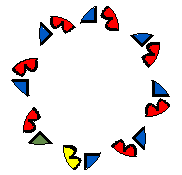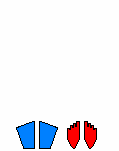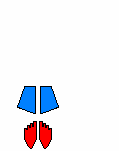Folk dance from Denmark
Stødt kanel (Pounded Cinnamon)
|
| Niels Mejlhede Jensen, Bøgeløvsvej 4, 2830 Virum, Denmark.
e-mail
(web master) |
Link (back) to the main page with music, which
may be just behind here, so you instead only need to close this window.
Dance description:
 |
Family waltz: Stødt kanel (Pounded Cinnamon)
-
Dance of many couples, all couples; a mixer
-
Waltz steps ( 3 steps per bar)
-
The dance is in 2 sections: a, b :
-
a: bar 1-4: big circle holding hands, waltz towards stranger and then partner
-
b: bar 5-8: waltz in couples (with the stranger = new partner) in line
of dancing
. |
 |
Tyrolian steps in waltz, the basic waltz steps
-
Dance of a couple; lady's left hand in gent's right hand
-
Waltz steps straight forward, 2 bars
-
This is repeated with the same steps in the next 2 bars
-
(This is then continued with 4 bars of couple dance turning 2 rounds, see
below)
Tyrolean waltz steps + waltz around (4+4 bars) = tyrolese waltz is often
danced when just any waltz melody is played.
The waltz steps shown here are basic steps for waltz: left, right,
together; right, left, together.
In the family waltz in a big circle, section a, a modified form of
this step is used to dance towards the stranger, 1 bar, (gent: left foot
and lady: right foot); and then towards partner, 1 bar. |
 |
Waltz around in couples (= Vienna waltz)
-
Dance of a couple; ordinary position: lady's right hand in gent's left
hand.
-
Waltz steps around.
The waltz shown here is very schematic, with the feet pointing in only
4 directions. The directions in between are also used in a smooth waltz. |
Stødt kanel (Pounded Cinnamon) - family waltz, dance of many couples,
all couples
|
| bar 1 |
 |
All couples form a big circle, holding hands. Gent has his partner
to his right and the "strange lady" to his left.
Everybody dance waltz towards stranger (left, right, together, for
the gent and opposite feet for the lady). |
| bar 2 |
 |
Then waltz towards partner (right, left, together, for the gent).
Then again towards stranger, and towards partner, in bar 3 and 4.
Then the stranger is chosen as the new partner, for ... |
| bar 5 |
 |
... waltz around in couples in the line of dancing in the ballroom,
for 4 bars |
| bar 6 |
 |
After the waltz around in couples, the circle is formed again, the
gent having his new partner on his right. |
The dance is repeated as long as pleased.
The basic steps in the waltz here are the same as for "Vienna waltz",
but danced slower. With "left, right, together", it is well defined, and
the easiest waltz to learn, and in this way we dance waltz practically
all over Denmark today. It was decided in Copenhagen in 1944 (Vejledning
for ledere i folkedans), that waltz in Danish folk dance should be Vienna
waltz. This is though not the waltz I grew up with, and not the waltz much
of Denmark in the countryside danced 100 years ago, to my knowledge. You
have to know this difference in waltz to understand some of the old dance
descriptions (found in archives, or on the attics). I will touch upon this
again when we get to another type of waltz: trippevals, (mince waltz).
Bottom of this page






